I have often noticed in my teaching that students seem to retain principles or concepts better if the accompanying musical illustrations substitute more exotic or unusual excerpts and composers in place of the steady diet of Germanic "piano sonata" literature found in many harmony texts. For instance, the "Nacht" from Pierrot Lunaire, the Passacaglia from Peter Grimes, or the final movement of Hindemith's Nobilissima Visione might replace a few typical Baroque continuous variations. Why not incorporate some Romantic examples of imitative/fugal practice—Berlioz's amusing "Amen" fugue on the death of a rat, Chopin's little known Fuga in A minor, or the final ensemble from Falstaff? Popular songs can on occasion provide excellent sources for chromatic third relations—Tea for Two ( ) or Just the Way You Look Tonight (
) or Just the Way You Look Tonight ( ).
).
In addition to widening the horizons of the students' musical repertory, this practice encourages them to form associations between apparently diverse masters through common compositional techniques. (What do Josquin, Schumann, Franck, and Webern have in common? Or for that matter, Machaut and Messiaen?) I would like to present two such instances, using "more" traditional literature (Beethoven and Wagner) on the one hand and "less" traditional (the Beatles) on the other, in the hope that the latter will serve to reinforce certain theoretical concepts of the former.
Motivic parallelism is currently one of the more "fashionable" analytical topics. It involves transferring the pitch classes of a surface motivic gesture to different levels of the tonal hierarchy. Charles Burkhart's seminal article (1978) mentions several of Schenker's analyses which touch on this area, including the opening movement of Beethoven's Op. 2, No. 1. The pitches of the original descending sixth figure (see Ex. 1A) recur as both foreground (mm. 94-104, 146-51) and middleground (mm. 69-79) events. This technique may also occur in the harmonic realm. Witness the increasing hierarchical settings of the progression Em - C (i - VI) in the second movement of Beethoven's Op. 14, No. 1: initiating the original statement, between the first and second reprises, and finally bridging the Scherzo and Trio (see Ex. 1B).
Example 1. Motivic/harmonic parallelism in Beethoven.
a. Piano Sonata in F minor, Opus 2, No. 1 ( I ).

b. Piano Sonata in E major, Opus 14, No. 1 ( II ).

Example 2 represents a tonal "reduction" of George Harrison's rock classic Something (No. 2 on side one of Abbey Road). The initial pitches of the introductory measure (A4-C 5-A4) are supported by IV. The second A ascends chromatically to tonic over passing chords ( and V). The song proper then retraces the inverted half-step motion at a more leisurely pace (C-
and V). The song proper then retraces the inverted half-step motion at a more leisurely pace (C- -
- -A) via I to IV. The anticipated sequence of the opening phrase (D-
-A) via I to IV. The anticipated sequence of the opening phrase (D- -
- -B) is abbreviated to D-C-B (over V/V to V), forming a two-measure appendage to the opening bars. The dominant moves deceptively to vi, now transposing the falling chromatics to A (A-
-B) is abbreviated to D-C-B (over V/V to V), forming a two-measure appendage to the opening bars. The dominant moves deceptively to vi, now transposing the falling chromatics to A (A- -
- -
- ) in an inner voice. The arrival at IV recycles us back to the beginning. The end of the repetition suddenly veers without warning into A major. The descending diatonic tetrachords which dominate this middle section are chromaticized at the end of each phrase with the familiar A-
) in an inner voice. The arrival at IV recycles us back to the beginning. The end of the repetition suddenly veers without warning into A major. The descending diatonic tetrachords which dominate this middle section are chromaticized at the end of each phrase with the familiar A- -
- -
- -(
-( -E). D and G major triads provide the means of pivotal return to the opening part. Vacillation between the two centers of A and C in the song's codetta anticipate significant tonal features of the album's second side. The resultant motivic parallelism is especially easy to see and hear. Relations arising from the initial tones A and C are gradually expanded in wider and wider vistas, eventually determining the basic keys of the song.
-E). D and G major triads provide the means of pivotal return to the opening part. Vacillation between the two centers of A and C in the song's codetta anticipate significant tonal features of the album's second side. The resultant motivic parallelism is especially easy to see and hear. Relations arising from the initial tones A and C are gradually expanded in wider and wider vistas, eventually determining the basic keys of the song.
Example 2. Motivic parallelism in Harrison's Something.
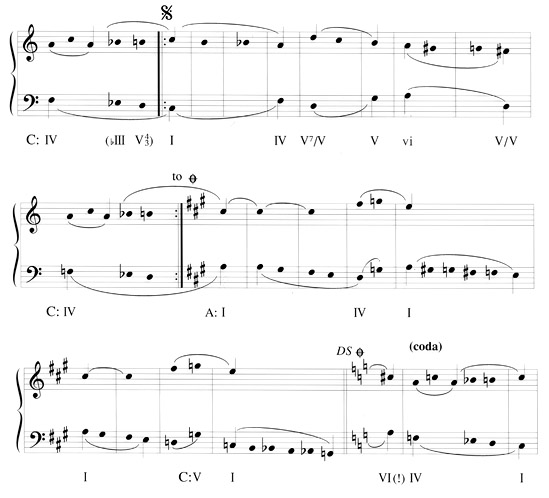
In turning to a consideration of the overall thematic/tonal structure of the orchestral Prelude to Act I of Wagner's Tristan und Isolde, I have resorted to a concept that is sometimes neglected in this age of reductive graphing and set complexes—that of rhetorical phrase and punctuation, or the statement of a musical idea and its subsequent expansion/extension, ending with a sense of cadential close. A brief review of the significant motives of the Prelude is provided in Ex. 3; they are numbered according to Burkhart's anthology (1986). Aside from the opening sixth gesture 1A, the melodic material basically alternates between the chromatic 1B and the diatonic 2. Motive 3 combines characteristics of 1B and 2, while 5 is strongly derivative of 1B. The seventh-chord outline in 6 is sequenced in ascending stepwise motion.
Example 3. Basic leitmotives in the Tristan Prelude.
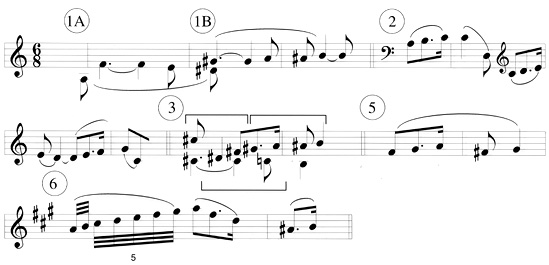
The initial seventeen measures constitute the most familiar section of the Prelude to most students; consult the reduction in Ex. 4. While basically prolonging the dominant of A (minor), the three-fold gestures anticipate the work's main tonal centers by the implied resolution of their respective V7s: i, III, and V (or A minor, C major, and E major). Within the chromatic  octave span in the soprano is enharmonically embedded the second of the so-called "Tristan" chords (
octave span in the soprano is enharmonically embedded the second of the so-called "Tristan" chords ( -B-D-
-B-D- ). Although other features could be enumerated, it is not our intention to dwell at length on details of the musical surface nor engage in endless speculation on the opening harmonies,1 but rather provide the student with an overall view of how the Prelude operates as a whole.
). Although other features could be enumerated, it is not our intention to dwell at length on details of the musical surface nor engage in endless speculation on the opening harmonies,1 but rather provide the student with an overall view of how the Prelude operates as a whole.
Example 4. Reduction of opening dominant prolongation in Tristan Prelude.
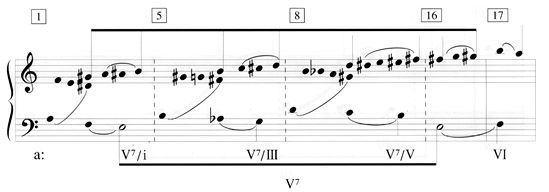
One possible means of diagramming the basic structure of this work is shown in Fig. 1. The boxes enclose four major sections, entitled Statement, Partial Restatement (or Expansion), Climactic Plateau, and Dissolution by Robert Morgan (1984). The successive subdivisions are arranged in three columns according to similar thematic and tonal content, with primary and secondary cadential points marked by  and
and  respectively. A foundational bass line and significant areas of tonicization are included.
respectively. A foundational bass line and significant areas of tonicization are included.
Figure 1. Structural diagram of Tristan Prelude.
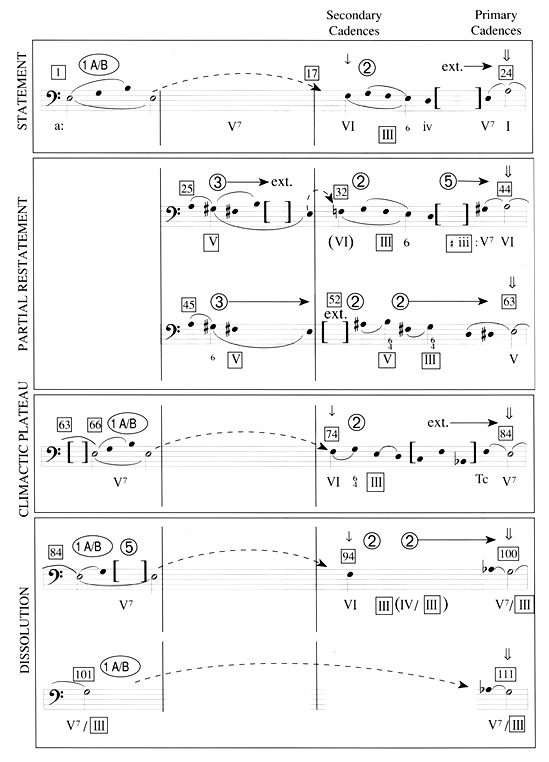
The first column charts the occurrences of 1A/B. The original dominant prolongation (mm. 1-16) returns at the openings of the Climactic Plateau and Dissolution. In each case the V7 cadences deceptively on VI (F Major), initiating a shift to III (C major). In its push toward the climax the second of these (mm. 66-73) is severely truncated, while the latter (mm. 84-93) interpolates material from Motive 5. The final incomplete statement of 1A/B extends the V of C.
The third column aligns the successive occurrences of Motive 2. This diatonic C major theme is crucial to the psychological profile of the work,2 since with each repetition, it is intensified through register, dynamics, increased dissonance and chromaticism, overlapped phrasing, and even the addition of a countermelody, producing a kind of expanding wave form that reaches its apex in the climactic extension of measures 77-83. Even though we never hear a pure root-position C tonic triad in the entire Prelude (but this is also true of the first 274 measures of Schumann's C major Piano Fantasy), the sense of tonicization is nevertheless unmistakable. In each appearance Motive 2 is either extended or repeated in approaching the major cadential punctuations of the Prelude (vertically aligned with a  at the end of the column). The only harmonic close on the (major) tonic logically occurs at the conclusion of the original Statement (mm. 1-24). Although the next cadence is also on A, it results from a deceptive V7 - VI in the subsidiary area of
at the end of the column). The only harmonic close on the (major) tonic logically occurs at the conclusion of the original Statement (mm. 1-24). Although the next cadence is also on A, it results from a deceptive V7 - VI in the subsidiary area of  (
( minor). In both instances this allows the suspended bass note (A2-A2-
minor). In both instances this allows the suspended bass note (A2-A2- 2) to initiate Motive 3 in the dominant key (E major). The following pair of half closes elide into the Climactic Plateau and Dissolution sections respectively. The final two cadential points are anchored on G, the dominant of C. Thus the series of harmonic closes move progressively away from the original tonic, culminating in the eventual V of the ensuing C minor (Act I).
2) to initiate Motive 3 in the dominant key (E major). The following pair of half closes elide into the Climactic Plateau and Dissolution sections respectively. The final two cadential points are anchored on G, the dominant of C. Thus the series of harmonic closes move progressively away from the original tonic, culminating in the eventual V of the ensuing C minor (Act I).
Finally, the middle column charts the two occurrences of Motive 3 in V (E major) during the Partial Restatement section. In each case the tonal movement is directed back toward the transient C major of Motive 2.
Analysts have long wrestled with the problem of the lack of tonal closure exhibited by this work. William Mitchell (1967) contends that the Prelude is closed in A (invoking the concert ending). Using the C major conclusion of Act I as the basis of his thesis, Poundie Berstein (1983) has hypothesized that the Prelude must be considered in light of that key. Robert Bailey (1985), on the other hand, has proposed the presence of a "double-tonic" complex incorporating both A and C. Although I have tried to assume a more neutral stance to this point by denoting the major tonal centers in terms of both their relation to A minor and as possible independent surface key areas, in retrospect, I must confess more sympathy for Bailey's contention of the presence of a dual tonal axis in this work. Even though this concept has been recently abused through its questionable application to certain works of the late Romantic period (in particular, those of Brahms), it seems appropriate here. In terms of a prolonged tonic, both centers are relatively weak. The case for A lies in its two dominant extensions (the opening section mm. 1-17 and its return in mm. 63-73), the authentic cadence in measure 24, and the extensive use of its dominant key of E major. The center of C, on the other hand, gains importance from continuous recurrence (via Motive 2 and the final prolongation of its dominant.)
Two main issues appear to influence the tonal organization of this work: (1) the difficulty of determining the mode of the A center (minor vs. major), and (2) the continual vacillation between the tonicized tonal areas of A (as implied by its prolonged dominant) and C. Figure 2 illustrates one possible means of diagramming these two characteristics. The two vertical columns represent A minor and major respectively. The C major complex is "piggy-backed" on the first, not unlike the manner in which Motive 2 unfolds (A-C-E-G). Each pitch class represents a potential area of tonicization or prolongation. The As are reciprocal through modal interchange, while the E majors are identical. The nonequivalent C major and  minor arise out of the A mixture, while the G major represents the final destination (as V of C). The tonal motion from A to C is usually effected through F to G triads, while its reverse employs D minor to E chords. The enharmonic
minor arise out of the A mixture, while the G major represents the final destination (as V of C). The tonal motion from A to C is usually effected through F to G triads, while its reverse employs D minor to E chords. The enharmonic  -
- may resolve in either direction.3 The overall movement is charted by the line from E to G, the framing dominant prolongations that open and close the Prelude. Although the centers of A and C continue to perform pivotal roles in Act I, Wagner prefers to leave the overall issue of "which is tonic?" in doubt by concluding the opera in B major with recapitulated material from the Act II Love Duet.
may resolve in either direction.3 The overall movement is charted by the line from E to G, the framing dominant prolongations that open and close the Prelude. Although the centers of A and C continue to perform pivotal roles in Act I, Wagner prefers to leave the overall issue of "which is tonic?" in doubt by concluding the opera in B major with recapitulated material from the Act II Love Duet.
Figure 2. Possible tonal model for the Tristan Prelude.
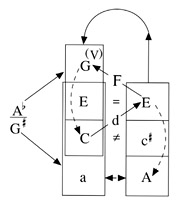
Now what do the Beatles have to do with all of this? Some years ago I was impressed on first hearing the second side of Abbey Road by the strong sense of compositional unification that its ten apparently disparate songs displayed. Further investigation resulted in the diagram shown in Fig. 3. The key, form, tempo, and text synopsis of each song is given. Although it must be admitted that the latter is frankly speculative, some sense of narrative continuity seems to emerge, perhaps making this one of the first instances of a "rock song cycle." In addition, there are several melodic and rhythmic motives which run throughout the entire group (also keep in mind the C major/A major oscillation of Harrison's Something on the first side).
Figure 3. Structural diagram of Abbey Road, side 2.
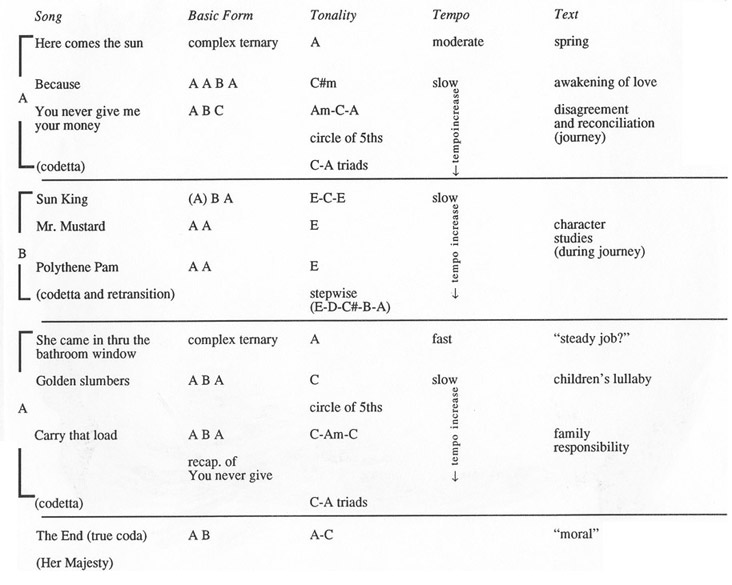
This portion of the album is divided into three large parts with an appended coda. While the opening Here Comes the Sun is clearly in A major, its middle section features a reiterated series of shifts toward C, which then cycle back through ascending 5ths ( -
- -D-A). The contrasting
-D-A). The contrasting  minor center of Because makes continual reference to the A7 chord as V7 of
minor center of Because makes continual reference to the A7 chord as V7 of  .4 The modal change to A minor in You Never Give Me Your Money features a circle of diatonic descending 5th relations. The modulation to C, its relative major, is immediately followed by a return to the original A major. The brief codetta consists of reiterated C and A major triads. Thus the basic area of A is somewhat undermined by constant allusions to
.4 The modal change to A minor in You Never Give Me Your Money features a circle of diatonic descending 5th relations. The modulation to C, its relative major, is immediately followed by a return to the original A major. The brief codetta consists of reiterated C and A major triads. Thus the basic area of A is somewhat undermined by constant allusions to  or C.
or C.
The "character pieces" of the middle part are set in the dominant area of E major. Nevertheless, C major continues to resurface as the interior section of the Sun King (note the harmonic similarity to Something) and as a prominent  in the other songs. An increase of tempo propels us to a "retransition," concluding with a step-wise motion from E back to A (E-D-
in the other songs. An increase of tempo propels us to a "retransition," concluding with a step-wise motion from E back to A (E-D- -B-A).
-B-A).
The final part returns to the original A major of She Came in Through the Bathroom Window. However, from here on C major assumes increasing importance. Golden Slumbers, which in retrospect symbolically represents the Beatles poignant Abschied to the 1960s, reactivates the circle of 5th technique, but now in C. Even the following Carry that Load features a recapitulation of You Never Give Me Your Money. Although the codetta once more employs the C/A major triad ostinato, the tonal emphasis appears to have shifted in favor of C. The coda (appropriately entitled The End) begins in A major but then moves toward and concludes in C major!
One final comment is cogent. Have the Beatles suggested a witty resolution of our A/C tonic dilemma after all? After The End of Abbey Road, there is a silence of some 30 seconds, followed by a seemingly unrelated little ditty entitled Her Majesty, cast in D major. The intended final pitches are doubtless 5-1, but the last note is strangely missing, leaving us with a concluding A!5
In comparison to most rock albums of that period, the tonal organization of the second side of Abbey Road is nothing less than astounding. One strongly suspects that George Martin may have ultimately been responsible for the structure of this series of songs, some of which are apparently former "rejects." Be that as it may, what I find most intriguing is the tonal conflict created by the struggle for control between the two chief protagonists of A and C. Are we perhaps dealing here with some kind of "rock double-tonic"? A most remarkable coincidence is that its basic tonal centers are identical with those of the Tristan Prelude, even to the subsidiary use of  minor: A Major/minor, C major, and E major. Also note in the Wagner that more emphasis is given to A and C in the outer sections, while the middle part stresses the dominant key of E. This pair of works in wildly differing style systems nevertheless presents two manifestations of the same possible "double-tonic" technique, and therefore could be advantageously employed to reinforce each other in the classroom!
minor: A Major/minor, C major, and E major. Also note in the Wagner that more emphasis is given to A and C in the outer sections, while the middle part stresses the dominant key of E. This pair of works in wildly differing style systems nevertheless presents two manifestations of the same possible "double-tonic" technique, and therefore could be advantageously employed to reinforce each other in the classroom!
For some teachers, the comparison of compositional devices in such wildly contrasting styles might represent an extreme remedy. Although I certainly am not pleading in favor of a "tit-for-tat" relation of some popular piece for every classical work studied, I do believe that the exploration of a more diverse and wider range of literature than the standard masterworks of the common practice German school is beneficial and refreshing to both student and instructor.
SOURCES
Bailey, Robert. Prelude and Transfiguration from Tristan and Isolde Norton Critical Score Series (New York: Norton, 1985), 113ff.
Berstein, Poundie. "A New View of Tristan: Tonal Unity in the Prelude and Conclusion of Act I" Theory and Practice 8/1 (Sept. 1983), 15-41.
Burkhart, Charles. "Schenker's 'Motivic Parallelism'" Journal of Music Theory 22/2 (Fall 1978), 145-75.
Burkhart, Charles. Anthology of Musical Analysis 4th ed. (New York: Holt, Rinehart, and Winston, 1986), 377.
Lewisohn, Mark. The Beatles: Recording Sessions (New York: Crown Publishing Inc., 1988).
Mitchell, William. "The Tristan Prelude: Technique and Structure" The Music Forum 1 (1967), 162-203.
Morgan, Robert. "Formal Circularity in the Tristan Prelude" delivered at the AMS/SMT Convention in Philadelphia, 1984.
Nattiez, Jean-Jacques. "The Concepts of Plot and Seriation: Process in Music Analysis" trans. Catherine Dale, Music Analysis 4/1 and 2 (March/July 1985), 108-12.
1I have refrained from any extended discourse in the text as to whether the so-called "Tristan Chord" is a Ø7th or a Fr . Despite Nattiez's (1985) statement that "its analysis is undecidable," I believe an examination of the Prelude, the rest of Tristan, and his other music dramas convincingly demonstrates that Wagner intended us to hear the former. He continually associated the Ø7th with the darker forces of the Supernatural, Destiny, and Magic. It was often followed by a Mm7th sonority, creating two-chord progressions of varying functional sense, of which the opening Tristan gesture is but one sub-set. In addition to the Tristan Prelude (mm. 81-84 and 107-9) see the following pages/measures of the Schirmer vocal score: 163 (mm. 1-5), 161 (mm. 16-19 where all three TCs occur in rearranged order), 223 (mm. 11-12), and 256 (mm.6-7). All occur at the original pitch level. Instances of the Ø7th chord include Ortrud's motive (beginning of Act II of Lohengrin), the Ring/Curse complex in Der Ring, the Magic Potion (Act I of Götterdämmerung), and the Tarnhelm (conclusion of Act I of Götterdämmerung). Expansions to the two-chord progression may be found in the Fate/Destiny motive (Der Ring), Kundry (Act II of Parsifal), Klingsor's Magic (Act II of Parsifal), the Rhinemaidens' Warning (Act III of Götterdämmerung), and the Ravens (Act I of Götterdämmerung).
. Despite Nattiez's (1985) statement that "its analysis is undecidable," I believe an examination of the Prelude, the rest of Tristan, and his other music dramas convincingly demonstrates that Wagner intended us to hear the former. He continually associated the Ø7th with the darker forces of the Supernatural, Destiny, and Magic. It was often followed by a Mm7th sonority, creating two-chord progressions of varying functional sense, of which the opening Tristan gesture is but one sub-set. In addition to the Tristan Prelude (mm. 81-84 and 107-9) see the following pages/measures of the Schirmer vocal score: 163 (mm. 1-5), 161 (mm. 16-19 where all three TCs occur in rearranged order), 223 (mm. 11-12), and 256 (mm.6-7). All occur at the original pitch level. Instances of the Ø7th chord include Ortrud's motive (beginning of Act II of Lohengrin), the Ring/Curse complex in Der Ring, the Magic Potion (Act I of Götterdämmerung), and the Tarnhelm (conclusion of Act I of Götterdämmerung). Expansions to the two-chord progression may be found in the Fate/Destiny motive (Der Ring), Kundry (Act II of Parsifal), Klingsor's Magic (Act II of Parsifal), the Rhinemaidens' Warning (Act III of Götterdämmerung), and the Ravens (Act I of Götterdämmerung).
2Motive 2 also occurs in E major (mm. 55-58) and F major (mm. 96-99) once each.
3See measures 99-100, 104-5, 109-10, where the  resolves to G.
resolves to G.
4Paul McCartney commented that he was influenced by the first movement of Beethoven's Moonlight Sonata while composing this song; observe the  minor tonality and the emphasis on
minor tonality and the emphasis on  .
.
5John Kurlander, the engineer during the recording sessions of Abbey Road states that Her Majesty had originally been positioned after Mean Mr. Mustard, but was deleted by McCartney. Although Kurlander later spliced it in at the conclusion of the side, the final D major chord was missing, having been "mixed" in the previous songs. Refer to p. 183 of Mark Lewisohn (1988).


